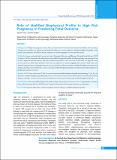Please use this identifier to cite or link to this item:
https://hdl.handle.net/20.500.14356/1271Full metadata record
| DC Field | Value | Language |
|---|---|---|
| dc.contributor.author | jha, Santosh | - |
| dc.contributor.author | Dangal, Ganesh | - |
| dc.date.accessioned | 2023-05-04T06:59:38Z | - |
| dc.date.available | 2023-05-04T06:59:38Z | - |
| dc.date.issued | 2020 | - |
| dc.identifier.citation | jhaS., & DangalG. (2020). Role of Modified Biophysical Profile in High Risk Pregnancy in Predicting Fetal Outcome. Journal of Nepal Health Research Council, 18(3), 401-405. https://doi.org/10.33314/jnhrc.v18i3.2513 | en_US |
| dc.identifier.issn | Print ISSN: 1727-5482; Online ISSN: 1999-6217 | - |
| dc.identifier.uri | http://103.69.126.140:8080/handle/20.500.14356/1271 | - |
| dc.description | Original Article | en_US |
| dc.description.abstract | Abstract Background: High risk pregnant women have increased risk of maternal and neonatal morbidity and mortality. Antepartum surveillance is important and should be effective in such conditions. Modified biophysical profile is the method of antepartum surveillance which comprises of cardiotocography and amniotic fluid index. Methods: A cross-sectional study was carried out in Paropakar Maternity and Women’s Hospital from February 2019 to January 2020 to determine the effectiveness of modified biophysical profile. Cardiotocography was interpreted as reactive, equivocal and non-reactive. AFI was considered normal if it was 5 to 24 cm. In the study 172 high risk cases at term and not in labor were included. Each case was subjected to cardiotocography then amniotic fluid index was obtained using real time sonography where it was measured from all four quadrants. Modified biophysical results were obtained and then were divided into 2 arms as normal modified biophysical profile and abnormal modified biophysical profile then analysis was done. Results: Of 172 cases, there were 97 (56.4%) cases in normal modified biophysical profile and remaining 75 (43.6%) in abnormal modified biophysical profile group. The rate of cesarean section increased when there was abnormal modified biophysical profile. Neonatal resuscitation and admission was increased in abnormal modified biophysical profile. Conclusions: Normal modified biophysical profile in high risk pregnancy had more cases of vaginal delivery and less adverse fetal outcome like low APGAR score, neonatal resuscitation and neonatal intensive care admission. Keywords: Amniotic fluid index; cardiotocography; fetal surveillance; modified biophysical profile | en_US |
| dc.language.iso | en | en_US |
| dc.publisher | Nepal Health Research Council | en_US |
| dc.relation.ispartofseries | Jul-Sep 2020; | - |
| dc.subject | Amniotic fluid index | en_US |
| dc.subject | Cardiotocography | en_US |
| dc.subject | Fetal surveillance | en_US |
| dc.subject | Modified biophysical profile | en_US |
| dc.title | Role of Modified Biophysical Profile in High Risk Pregnancy in Predicting Fetal Outcome | en_US |
| dc.type | Journal Article | en_US |
| local.journal.category | Original Article | - |
| Appears in Collections: | Vol. 18 No. 3 (2020): Vol. 18 No. 3 Issue 48 Jul-Sep 2020 | |
Files in This Item:
| File | Description | Size | Format | |
|---|---|---|---|---|
| 2513-Manuscript-18831-1-10-20201115.pdf | Fulltext Article. | 209.94 kB | Adobe PDF |  View/Open |
Items in DSpace are protected by copyright, with all rights reserved, unless otherwise indicated.
